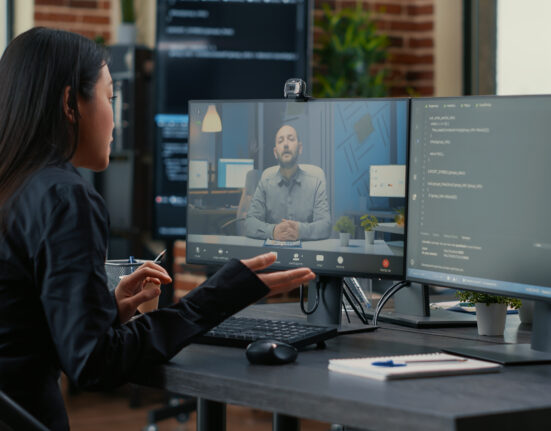Hybrid Work Environments
One of the most significant trends in video conferencing is the rise of hybrid work environments. The COVID-19 pandemic forced a massive shift to remote work, and organizations worldwide adapted by relying on video conferencing tools like Zoom, Microsoft Teams, and Slack. As the world transitions beyond the pandemic, many companies are adopting a hybrid work model, combining remote and in-office work. Video conferencing and messaging platforms will continue to play a vital role in bridging the gap between remote and in-person employees, enabling seamless communication and collaboration.
Enhanced Security and Privacy Features
As the use of video conferencing platforms for sensitive meetings and discussions increases, the demand for enhanced security and privacy features has grown. Video conferencing companies have responded by implementing end-to-end encryption, two-factor authentication, and advanced security settings. These measures help protect users’ data and ensure confidential conversations remain private, making video conferencing tools more attractive to businesses and individuals.
AI-Powered Features
Artificial intelligence (AI) has made a significant impact on video conferencing and messaging platforms. AI is used to improve video quality, reduce background noise, and enhance user experiences. Additionally, AI-powered chatbots and virtual assistants are becoming increasingly integrated into messaging platforms, offering automated responses and support to users. These features streamline communication and help manage large volumes of messages and requests.
Customization and Personalization
Personalization is a growing trend in both video conferencing and messaging platforms. Users now expect the ability to customize their profiles, backgrounds, and settings to create a more individualized experience. For businesses, customization options allow for branding and creating a unique online environment for team meetings and client interactions.
Integration of Collaboration Tools
To streamline work processes and improve productivity, video conferencing and messaging platforms are integrating with other collaboration tools. Users can now seamlessly switch between video conferencing, document sharing, project management, and more within a single platform. This integration helps users access all the tools they need for efficient collaboration without switching between different apps.
Virtual and Augmented Reality Integration
Virtual and augmented reality (VR and AR) are making their way into the video conferencing space. While still in the early stages, some platforms are experimenting with VR meeting rooms and AR-enhanced presentations. These technologies have the potential to revolutionize remote meetings and provide more immersive experiences in the future.
Environmental Sustainability
The environmental impact of technology is an increasingly relevant concern. Video conferencing platforms have responded by developing features that allow users to track their carbon footprint and make environmentally conscious choices. This includes optimizing video quality to reduce energy consumption and promoting eco-friendly practices such as reducing travel for meetings.
Globalization and Language Support
The globalization of business and the increased availability of remote work have created a demand for language support in video conferencing and messaging platforms. Users expect real-time translation, transcription, and language support to facilitate communication across borders and languages. These features enhance cross-cultural collaboration and open new opportunities for businesses.
Health and Well-being Features
The pandemic brought a focus on mental health and well-being. Video conferencing and messaging platforms are integrating features such as virtual water cooler chats, wellness resources, and reminders to take breaks to address employee health and work-life balance. These features aim to create a more supportive and holistic work environment.
Accessibility and Inclusivity
Trends in Video Conferencing and Messaging Platforms, Accessibility is a growing concern in video conferencing and messaging platforms. Companies are working to ensure their tools are usable by individuals with disabilities by offering features like closed captions, screen readers, and keyboard shortcuts. This trend promotes inclusivity and allows a wider range of users to participate in digital communication.
Subscription Models and Monetization
Many platforms have introduced subscription models, offering premium features and services for a fee. This approach allows companies to generate revenue and invest in ongoing improvements. The trend towards monetization is changing the landscape of video conferencing and messaging, as some services may become accessible only to paid subscribers.
Blockchain Integration
Blockchain technology is being explored for secure and transparent communication. It has the potential to provide secure identity verification, data encryption, and privacy features in messaging and conferencing platforms. While still in its early stages, blockchain integration could address some of the data privacy and security concerns associated with digital communication.
Conclusion
Trends in Video Conferencing and Messaging Platforms, Video conferencing and messaging platforms have evolved from simple tools for communication to sophisticated, integrated ecosystems that facilitate collaboration, productivity, and connection in our personal and professional lives. The trends in this space reflect the changing needs and expectations of users in a rapidly evolving digital landscape.
The shift to hybrid work environments, enhanced security and privacy features, AI-powered tools, and the integration of collaboration and customization options are shaping the future of remote work and communication. Virtual and augmented reality, language support, sustainability, and accessibility are broadening the possibilities for how we interact and collaborate online.
As technology continues to advance, we can expect further innovation in video conferencing and messaging platforms, ultimately providing us with more efficient, inclusive, and sustainable means of communication and collaboration. These trends will continue to influence how we work, connect, and share in the digital age.















Leave feedback about this